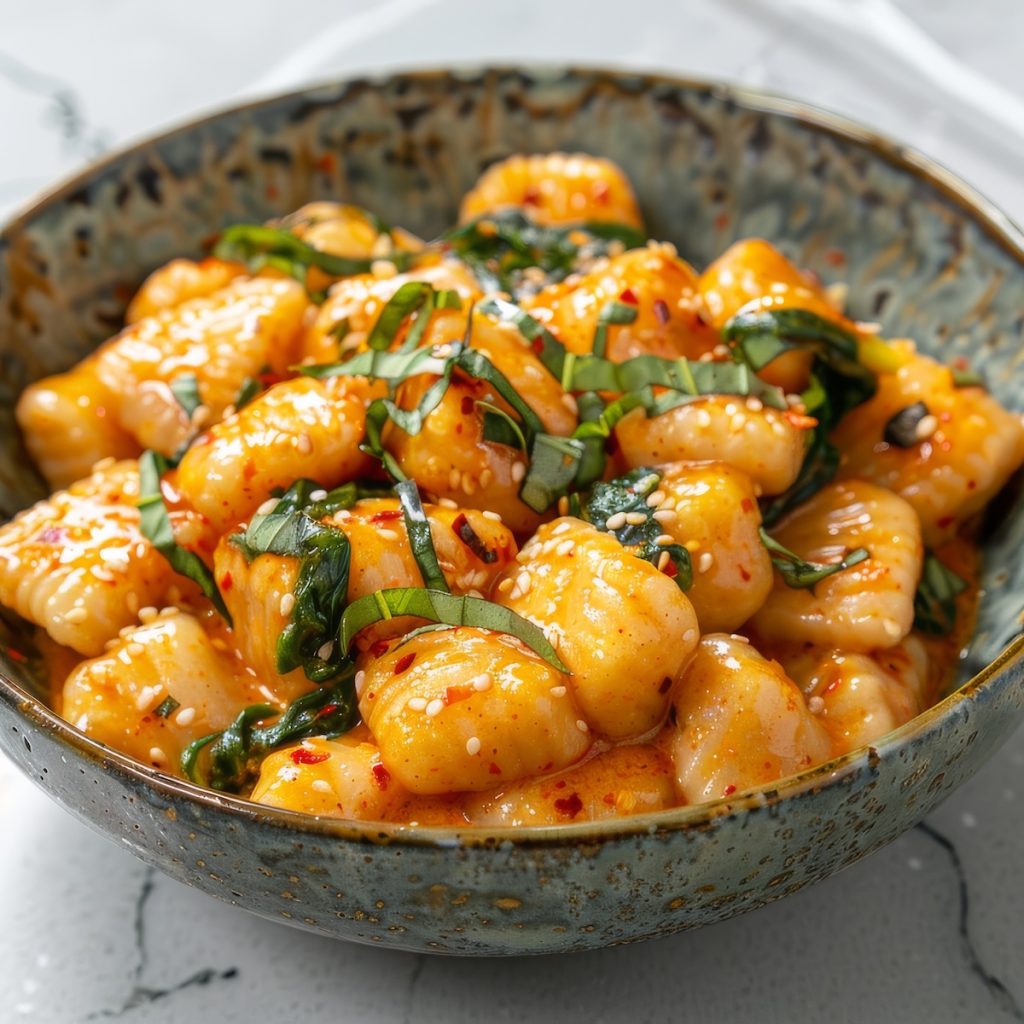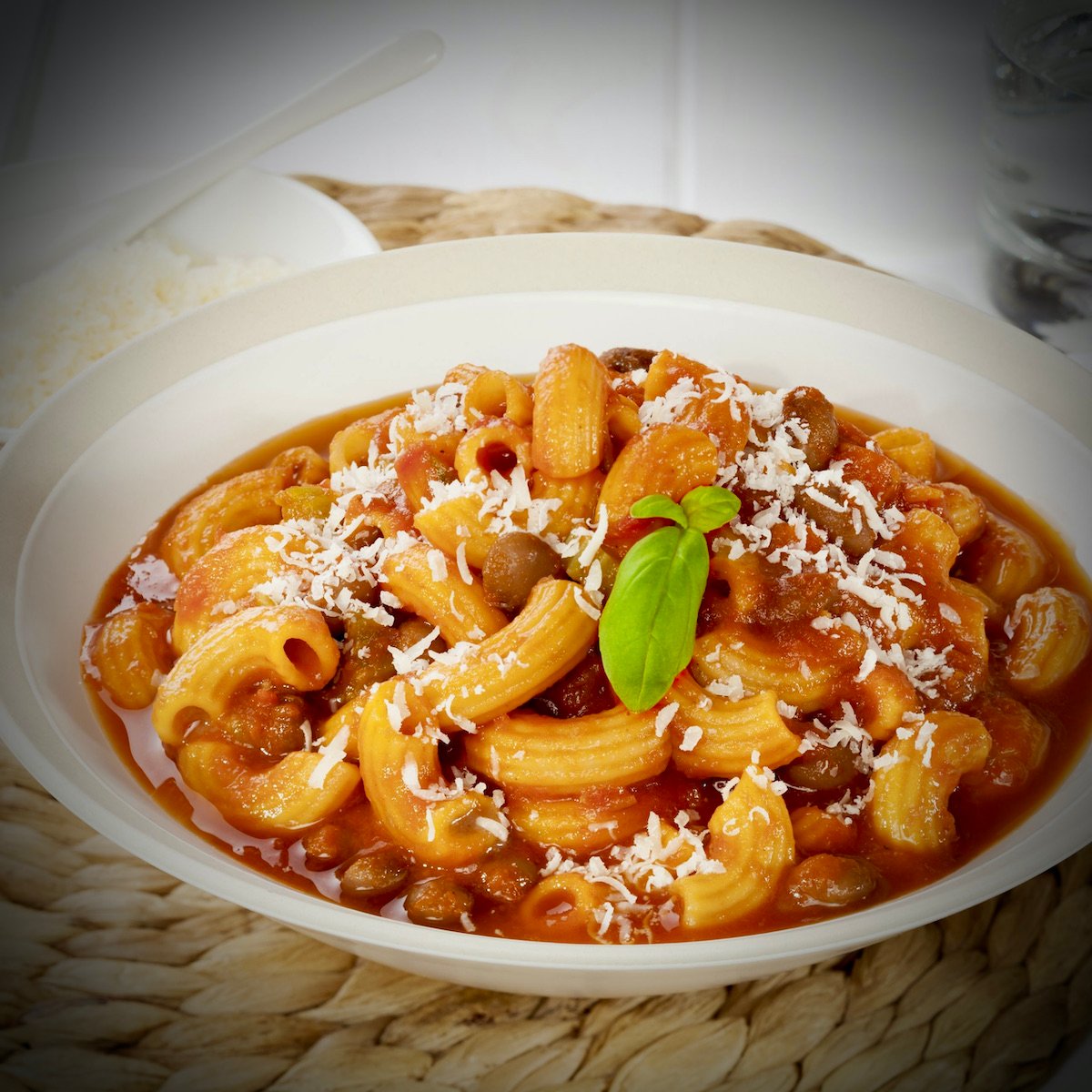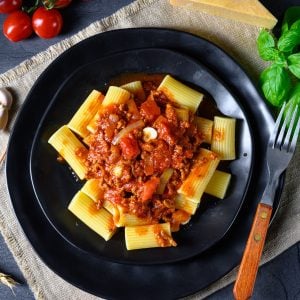Spice Up Pasta Night: Creamy Gochujang Gnocchi Recipe
Are you looking to spice up your pasta nights with a unique twist? This creamy gochujang gnocchi recipe perfectly fuses Italian comfort food and bold Korean flavors. Gochujang, a staple in Korean cuisine, brings a rich, spicy-sweet kick that perfectly complements the soft, pillowy gnocchi. Paired with a creamy sauce, this dish offers a delightful balance of heat and comfort, making it a standout choice for any meal.
This recipe shows you how to create a luscious, velvety sauce using gochujang, cream, and a hint of garlic, ensuring each bite is flavorful. The gnocchi, which can be homemade or store-bought, absorbs the sauce beautifully, creating a mouthwatering dish sure to impress.
Whether you’re a seasoned chef or a home cook looking to try something new, this creamy gochujang gnocchi is a breeze to prepare. Its simplicity and the promise of restaurant-quality results will surely boost your confidence in the kitchen. Perfect for a cozy dinner at home or a special occasion, it’s a dish that brings a touch of global fusion to your table. Ready to dive into this delicious culinary adventure?
What Is Gochujang?
Gochujang is a staple condiment in Korean cuisine, renowned for its rich, spicy-sweet flavor profile. It’s a fermented chili paste made from red chili peppers, glutinous rice, fermented soybeans, and salt. The paste undergoes a fermentation process that can last several months to develop its complex flavors.
Regarding taste, gochujang offers a unique combination of spiciness from the chili peppers, sweetness from the glutinous rice, and a savory umami depth from the fermented soybeans. Its thick and sticky texture makes it versatile for cooking and condiment use.
This versatile ingredient adds heat and depth to dishes and serves as a base for various sauces, marinades, and dips in Korean cooking. Its adaptability is a key component in iconic dishes like bibimbap, tteokbokki, and Korean barbecue marinades. The possibilities with gochujang are endless, inspiring you to create your own unique culinary masterpieces.
Gochujang’s popularity has transcended Korean cuisine, gaining recognition globally for its bold flavors and ability to elevate a wide range of dishes. Whether exploring new recipes or enhancing your favorite meals, using gochujang adds a distinctive taste that is part of a global culinary trend. It’s a delightful twist to any culinary creation that you won’t want to miss out on.
Gochujang History
Gochujang has a rich history that dates back centuries and is deeply rooted in Korean culture and cuisine. The origins of gochujang can be traced to the Three Kingdoms period (57 BCE – 668 CE), though it became more prominent during the Joseon Dynasty (1392-1897). Here’s a closer look at its historical development:
Early Origins
- Ancient Period: While chili peppers, a key ingredient in gochujang, were introduced to Korea much later, the concept of fermented soybean pastes, similar to the base of gochujang, existed in Korea since ancient times. Fermentation was a common method of food preservation and flavor enhancement.
- Introduction of Chili Peppers: Chili peppers were introduced to Korea in the 16th century via trade with Japan and China, which had received them from the New World through European traders. This pivotal moment for Korean cuisine led to the development of gochujang as we know it today.
Development and Popularization
- Joseon Dynasty: Gochujang production became more refined and widespread during this period. Combining chili peppers with fermented soybean paste, glutinous rice, and salt created a unique condiment that became a staple in Korean households. Traditional recipes were passed down through generations, with each family often having its version.
- Fermentation Process: The traditional method of making gochujang involves fermenting the mixture in earthenware pots (jangdok) for extended periods, allowing the flavors to develop deeply. The fermentation process is influenced by the local climate and environment, adding to the uniqueness of each batch.
Modern Era
- Industrialization: In the 20th century, with advancements in food production and preservation, gochujang became commercially available, making it accessible to a broader audience in Korea and internationally. Mass production methods ensured consistency and availability year-round.
- Global Popularity: Gochujang has gained international recognition in recent decades as Korean cuisine has spread worldwide. Its distinctive flavor and versatility have made it a favorite ingredient among chefs and home cooks looking to add a spicy, umami-rich kick to their dishes.
Cultural Significance
- Culinary Tradition: Gochujang is not just a condiment but a cultural symbol in Korean cuisine. It is used in various dishes, including bibimbap, tteokbokki, stews, and marinades. Its presence in Korean cooking represents the country’s rich culinary heritage and love for bold, complex flavors.
- Health Benefits: Traditionally, gochujang was also valued for its health benefits. The fermentation process enhances the flavor and nutritional value, adding probiotics and aiding digestion.
Gochujang’s journey from a traditional Korean household staple to a global culinary phenomenon highlights its enduring appeal and versatility. Whether used in traditional Korean dishes or as an innovative ingredient in fusion cuisine, gochujang continues to captivate palates worldwide.
Substitutions
If you don’t have gochujang on hand, there are several alternatives you can use to mimic its unique spicy, sweet, and umami-rich flavor. Here are some substitutes:
1. Sriracha and Miso Paste
- Ingredients:
- 2 tablespoons Sriracha
- 1 tablespoon miso paste
- Instructions:
- Mix the Sriracha and miso paste together until well combined. This mixture will provide a similar spicy and umami flavor to gochujang.
2. Red Pepper Flakes, Soy Sauce, and Sugar
- Ingredients:
- 1 tablespoon red pepper flakes
- 2 tablespoons soy sauce
- 1 teaspoon sugar
- Instructions:
- Combine the red pepper flakes, soy sauce, and sugar to create a spicy and slightly sweet paste. Adjust the quantities to taste.
3. Chili Paste and Honey
- Ingredients:
- 2 tablespoons chili paste (such as sambal oelek)
- 1 tablespoon honey
- Instructions:
- Mix the chili paste and honey to achieve a balance of heat and sweetness similar to gochujang.
4. Harissa and Soy Sauce
- Ingredients:
- 2 tablespoons harissa
- 1 tablespoon soy sauce
- Instructions:
- Combine the harissa with soy sauce to add a bit of umami depth to the spicy harissa.
5. Doubanjiang (Fermented Broad Bean Paste) and Sugar
- Ingredients:
- 2 tablespoons doubanjiang
- 1 teaspoon sugar
- Instructions:
- Mix the doubanjiang with sugar to add sweetness to the spicy and savory paste.
6. Homemade Gochujang Substitute
- Ingredients:
- 2 tablespoons red pepper flakes
- 1 tablespoon miso paste
- 1 tablespoon soy sauce
- 1 tablespoon honey or sugar
- 1 teaspoon rice vinegar
- Instructions:
- Combine all the ingredients in a bowl and mix well to form a paste. Adjust the quantities to taste.
These substitutes won’t perfectly replicate gochujang’s unique flavor, but they will provide a similar balance of spiciness, sweetness, and umami that can work well in many recipes.
Gnocchi
Gnocchi (pronounced nyoh-kee) is an Italian pasta traditionally made from potatoes, flour, and sometimes eggs. These small dumplings are known for their soft, pillowy texture and are typically served with various sauces, from creamy cheeses to tangy tomato-based options.
Making gnocchi involves cooking and mashing potatoes, mixing them with flour and often eggs to form a dough, which is then shaped into small pieces. These pieces are usually scored with a fork to create ridges that help sauces adhere better. Gnocchi can vary in size and shape depending on regional traditions in Italy, but they are generally similar in texture—tender yet slightly chewy.
Once formed, gnocchi are boiled briefly until they float to the water’s surface, indicating they are cooked. They are then served with the sauce of choice, making them a versatile base for many Italian dishes. Gnocchi can also be made with alternative ingredients, such as ricotta cheese or semolina flour, offering different textures and flavors while retaining their characteristic softness.
Creamy Gochujang Gnocchi
Ingredients
For the Gnocchi
- 1 pound potato gnocchi
For the Sauce
- 2 tablespoons olive oil
- 4 cloves garlic minced
- 2 tablespoons gouchujang Korean red chili paste
- ½ cup heavy cream
- ¼ cup chicken broth vegetable broth for vegetarian option
- 1 tablespoon soy sauce
- 1 teaspoon honey optional for added sweetness
- salt and pepper to taste
- fresh cilantro for garnish
Instructions
Cook the Gnocchi
- Bring a large pot of salted water to a boil. Add the gnocchi and cook according to package instructions until they float to the surface, about 2-3 minutes. Drain and set aside.
Prepare the Sauce
- In a large skillet, heat the olive oil over medium heat. Add the minced garlic and sauté until fragrant, about 1 minute.
- Stir in the gochujang and cook for another 1-2 minutes, allowing the flavors to meld.
Combine Ingredients
- Pour in the heavy cream and chicken broth, stirring to combine. Bring the mixture to a gentle simmer, then add the soy sauce and honey if using. Let the sauce simmer for a few minutes until it thickens slightly.
Mix in Gnocchi
- Add the cooked gnocchi to the skillet, tossing gently to coat them in the creamy sauce. Cook for another 2-3 minutes, allowing the gnocchi to absorb the flavors.
Season and Serve
- Season with salt and pepper to taste. If desired, sprinkle grated Parmesan cheese on top and garnish with fresh cilantro or green onions.
Enjoy
- Serve the creamy gochujang gnocchi hot, and enjoy the delightful blend of spicy, creamy, and savory flavors!









2 Responses
Mr. Jones – Stumbled upon this recipe today, and it looked very promising. So, I went shopping and was able to gather the missing ingredient: Gouchujang Paste. The recipe came together easily on the first attempt, and was finished with green onions, cilantro and a some freshly ground black pepper. Absolutely love this! Thanks for sharing.
You are very welcome.